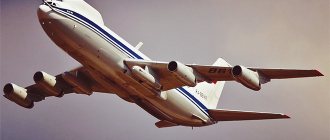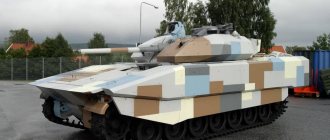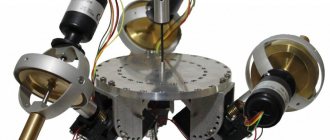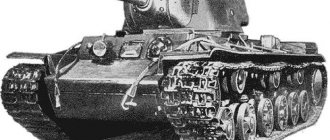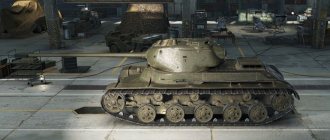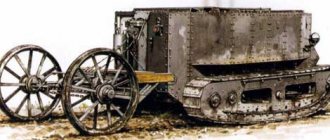T-34-122 assault tank project
In the Soviet army in the first years of the Great Patriotic War, there were a lot of problems, the main one of which was the lack of necessary weapons for effective combat operations. This includes the lack of self-propelled assault guns. These include only the KV-2, most of which were lost in battle, and the captured StuG III. To fill this vacuum, a self-propelled artillery mount and an “assault tank” based on the T-34 were developed in parallel. The main armament was to be the U-11 tank howitzer, developed on the basis of the M-30. In December 1942, the technical department of the People's Commissariat of Heavy Industry, at the request of the BTU, developed tactical and technical requirements for a tank for artillery reinforcement of tank brigades. This tank, according to the assignment, was supposed to retain the hull and chassis of the T-34 tank. The new vehicle required a new turret, and the armament was to use a 122mm assault gun with the ballistics of a 1938 howitzer.
The work on creating the machine was entrusted to three teams of designers at once - the UZTM design bureau (project manager L.I. Gorlitsky), the design bureau of plant No. 9 (head F.F. Petrov) and the Central Artillery Design Bureau (head V.G. Grabin)
Under the code U-37, the Ural Heavy Engineering Plant developed cast and stamped turrets, which in shape and dimensions were close to the T-34 turret, but to fit the shoulder straps of the KV tank. The armament was to be the 122-mm U-11 howitzer or the 85-mm U-10 cannon, developed by UZTM back in 1941-1942 by designers V.E. Sidorenko. and Usenko A.V. However, already at the stage of the mock-up commission meeting, it became clear that the proposed turrets were too small to accommodate the breech of an 85- or 122-mm gun and three crew members. In this regard, the UZTM project was rejected.
The project of the Central Artillery Design Bureau envisaged the installation of a 122- or 152-mm S-41 artillery system. This turret was offered not only for installation on the T-34, but also on the KV-1S. However, the TsAKB design in the T-34 turret with a shoulder strap with a diameter of 1420 millimeters could not be installed due to the large recoil reaction and excessive dimensions. In this regard, the project for the T-34 was rejected, but was recommended for installation in the KV tank.
The most attractive proposal was from the design bureau of plant No. 9. The plant's design bureau proposed a cast turret with vertical walls of increased height. Part of the ammunition was placed in the turret niche. It was proposed to arm the tank with a 122 mm D-6 assault gun, which was the fruit of technological simplification and refinement of the 122 mm U-11 gun and the unification of parts and components with the 85 mm D-5 gun. In the continuous numbering of products from plant No. 9, the specified turret received the factory index D-11 and could easily be rearmed with an 85-mm D-5 cannon. However, the dimensions of this tower were not enough to comfortably accommodate three crew members.
The developments of the design bureaus of Uralmashzavod and plant No. 9 were discussed for some time at the plenum of the Artillery Committee. So, for example, in order to avoid crowded traffic, it was proposed that the loader also be a gunner-radio operator and leave his seat only when the tank stops during firing. However, in this case, the vehicle would be left without protection from enemy infantry attacks. All attempts to find a way out of this situation were in vain. In the fall of 1943, due to the advent of the SU-152 and SU-122 self-propelled guns, work on the T-34-122 assault tank was stopped. The experimental T-34-122 assault tank in some documents was designated T-34Sh (assault) or T-34G (howitzer).
Design tactical and technical data: Combat weight - 30,000 kg. Crew - 4-5 people. Length - 6000 mm. Height - 3200 mm. Ground clearance - 400 mm. Armament: - 121.9 mm howitzer U-11; — two DT machine guns of 7.62 mm caliber. Reservation: Front and sides of the hull - 45 mm. Hull stern - 30 mm. The bottom and roof of the body are 20 mm. Tower - 60 mm. Engine - diesel, 12-cylinder, V-2-34, power 500 hp. Tank capacity - 620 l. Transmission - manual, 5-speed gearbox (4 forward and 1 reverse). Chassis - 5 rubber-coated dual main rollers, rear drive and front idler wheels. Speed - 30 km/h. Obstacles to overcome: Ditch width - 2.50 m. Wall height - 1.00 m. Ford depth - 1.50 m. Communications - radio station 71TK-3.
Prepared from materials: Alternathistory.org.ua Lib.rus.ec www.aviarmor.net www.tehnikapobedy.ru
Development of T-34 76
The T-34 was designed and assembled at the design bureau of the Kharkov Locomotive Plant. Not only the famous design bureau M.I. was involved in it. Koshkin, the Adolf Dick design bureau also participated in the work. The technical project in this bureau was prepared a whole month late, which is why A. Dick was arrested. As a result, only M. Koshkin became responsible for the project. In the process of work, the designers created two options for tank propulsion: wheeled-tracked and tracked; in the end, preference was given to the second. In March 1940, two samples of the new tank were delivered to the Kremlin’s Ivanovo Square to demonstrate it to the military commission and the government. It is worth noting that for this purpose, the new combat vehicles covered as much as 750 kilometers from Kharkov to Moscow under their own power, moving off-road, and thereby demonstrating excellent maneuverability. At the end of March, Soviet industry began producing tanks.
By the beginning of the Great Patriotic War, the T-34 tank was the best vehicle in the world, mobile, easy to manufacture, with projectile-proof armor and a powerful 76 mm gun, capable of penetrating any German tank of the 1941 model. The Germans' 37-millimeter guns were practically powerless against the T-34. Since 1941, the Wehrmacht began producing “Panzer III”, most of which were equipped with a 50 mm cannon, already more effective against the armor of the T 34. But penetration was ensured at a distance of no more than six hundred meters, and only if they fired a sub-caliber projectile, but the cannon The T-34 could penetrate the armor of early modifications of the Panzer III from two thousand meters. Later, Panzer modifications with 60 and 50 millimeters of armor appeared, but the T-34 penetrated it with armor-piercing shells from a distance of one and a half thousand meters. Even the later and strengthened Panzer III Ausf.M and Ausf.L models with 70 mm armor could be penetrated by the Thirty-Four from a distance of five hundred meters.
It is also worth noting the 45 mm armor of the T-34, which, due to its inclined design, often provoked ricochets when fired from long distances, which made it very difficult to fight this tank. But the T-34 also had disadvantages - poor visibility and a not very reliable transmission. In addition, the fighting compartment was quite cramped and greatly hampered the work of the crew.
Guns
The tank was initially equipped with a 76.2 mm L-11 model gun with a 30.5-caliber barrel. It had a number of shortcomings, so it was soon replaced by the more successful F-32 cannon. After some time, the design bureau developed a modification of this weapon, which was seriously superior to the previous version. The gun was named F-34, the length of its barrel increased to 41 caliber, which significantly increased the penetrating power of the gun. There was a 7.62 mm DT machine gun coaxial with the cannon, and a TOD-6 telescopic sight was used for direct fire of the gun.
Disadvantage of a self-propelled gun
At first glance, a tank with a 34 122 turret is inferior to a self-propelled gun, so it should be abandoned. However, it turned out to be the main fighting unit for an important reason. The absence of a turret does not allow free fire in all directions, so the crew has to perform complex maneuvers.
Practice has shown how, after the end of World War II, the Turkish authorities tried to adopt just such a self-propelled gun. However, the tank disappointed them with the need to turn 180 degrees when the enemy moved. As a result of this, 34 122 immediately lost its speed, which led to weakening maneuverability.
The only minus of the tank
Finally, we should consider the only weak point of the 34 122. Still, the tank could not be ideal due to certain design requirements. As a result, it is necessary to take into account weak armor in 2 places.
- Roof – 20 mm;
- Bottom 15 mm.
You can immediately see in what places a heavy combat unit can be damaged. Of course, this is still not easy to do, but individual soldiers managed to get close enough. For this reason, the weakness of the self-propelled gun was still taken into account, so motorized rifle companies were usually allocated to support it.
Tank 34 122 is an excellent example of a combat unit capable of storming any defensive structure. Yes, its mass production did not take place, but the project turned out to be one of the most successful. So we still managed to see machines in the ranks of the Red Army.
Discovery film about T-34
Why a howitzer?
Historians recall that 122 mm howitzers were never installed on tanks. Indeed, they were considered too heavy, and it was almost impossible to fire from them on the move. However, 34 122 acquired just such a tower, becoming the first and last example of the developers’ achievements.
The choice of howitzer was not accidental. The fact is that it was precisely such powerful weapons that were required for each successive assault. The crew of 5 people immediately replaced an entire company of soldiers who had to reach the enemy meters away. After the first hostilities, the only tank performed well, showing what the future of the Soviet Union was like.
Machine guns 7.62 – standard
In addition, the installation of machine guns on 34 122 did not seem unexpected. Almost all self-propelled guns had exactly this weapon, which helped cope with motorized rifle troops. It was for two machine guns that there were separate shooters who were part of the crew. They quickly dealt with the approaching soldiers, so there was no need to worry about the rear.
Powerful machine guns were tested many times in action, and their caliber corresponded to all automatic weapons of the Red Army. Because of this, their cartridges were considered replaceable, although the ammunition amazed even professionals who were accustomed to comparing WWII models with modern ones.
Engine
The T-34 76 tank was equipped with a V-2 diesel engine - a high-speed, compressor-free, water-cooled engine with jet fuel atomization and an operating power of 500 horsepower, at a speed of up to forty-seven kilometers per hour.


